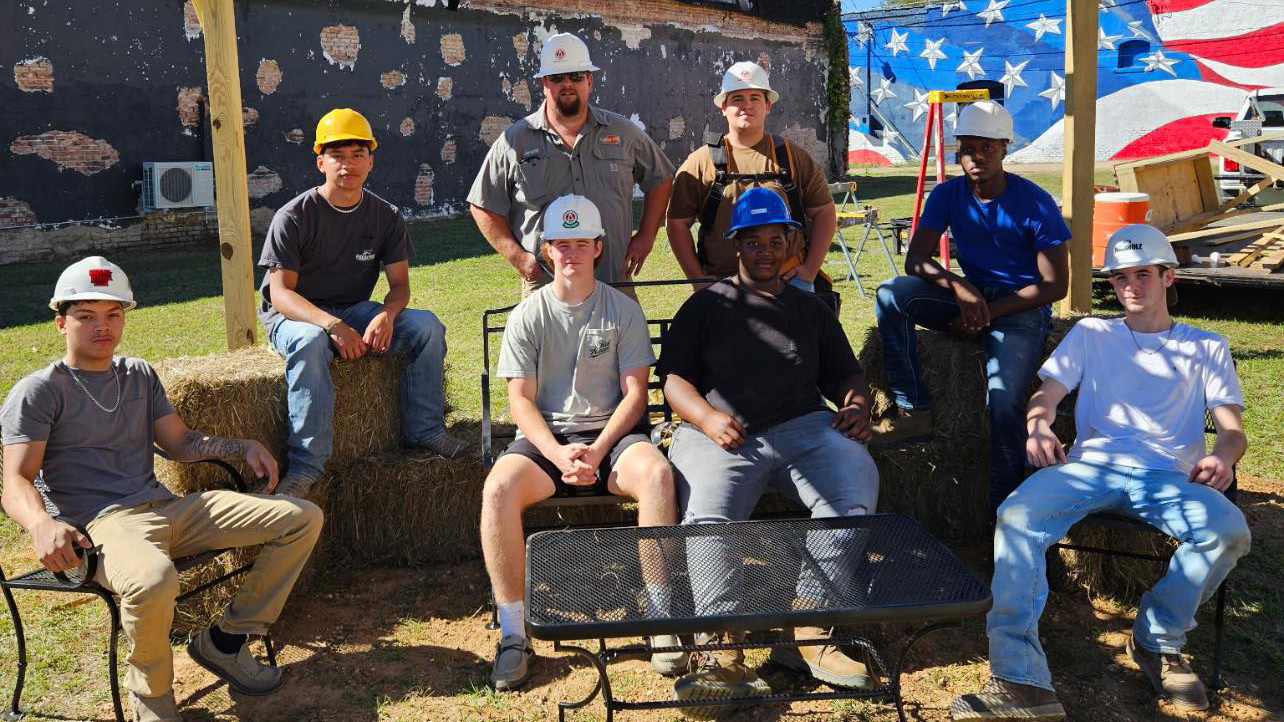MONTICELLO, Arkansas — Duck migration, bottomland hardwood forests, and drone use for mapping were just some topics discussed during a round table discussion with U.S. Fourth District Congressman Bruce Westerman, Hot Springs, AR. Westerman worked for 22 years as an engineer and forester by trade.
He spent the better part of Friday, October 28, on the UAM Campus, speaking to faculty and students at the College of Forestry, Agriculture, and Natural Resources. Most of the meeting was about the efforts made by the forestry, wildlife, and geospatial experts of the College to sustain the health of bottomland hardwood forests of Arkansas and the waterfowl that depend on them and to educate the next generation of wetlands and waterfowl managers.
Before the conversations about wetlands and wildlife began, Westerman made a presentation to Dr. Robert Ficklin, who was recently inducted as a Fellow to the Society of American Foresters (SAF), one of the highest honors of the profession. He presented a copy of the text he read into the Congressional Record earlier this month honoring Dr. Ficklin for receiving the SAF Fellow Award.

The working lunch at Gibson Hall provided an opportunity for the Congressman to have conversations with UAM faculty and students. The Director of the Five Oaks Ag Research and Education Center graduate certificate program, Dr. Douglas Osborne, explained the uniqueness of the public /private partnership of Five Oaks and the education its Graduate Certificate Program in Waterfowl Habitat and Recreation Management provides. Dr. Osborne talked about the beauty of being able to take students away from campus, put them out on the land, and let them get hands-on experience with water, land, and waterfowl management issues.
Osborne said, “George’s foundation has provided us the ability to put about fifty transmitters on mallards around Five Oaks, and we’re trying to let the mallards tell us what forest conditions they desire”, said Osborne. He added, “What are the birds selecting, what are they avoiding, and what are the characteristics of the forests that they’re not using? We hope we can inform and move the restoration process forward.” Dr. Ben Babst and his research on oak seedling responses to flooding were other research areas discussed. Babst is studying how to manage flooding in Green Tree Reservoirs managed for waterfowl habitat. His research is focused on determining the climate and soil conditions that govern when seedlings go dormant, at which point it is safer for them to be flooded without damage or mortality.

Dr. Ficklin then told Westerman about his research of establishing the linkages between soil conditions and tree health at Five Oaks. Ficklin said, “We have pulled more than 900 cores at one-meter depth in 12 green tree reservoirs,” said Ficklin. “We will be processing over 4500 samples for full chemical and physical characterization.” Dr. Hamdi Zurqani will then use these soil data with his geospatial models to develop soil physical and chemical maps more accurately than ever done with current methods. One potential management outcome of their research is determining which soil conditions enhance acorn production on species such as Nuttall oak, which is an important part of waterfowl diets.
After discussing the four scholarships funded for the graduate certificates, Osborne allowed each student to introduce themselves and explain their interest in water habitat and wetlands management. Osborne told Westerman that twenty-five people applied this year for the four scholarships. Osborne said,” there is a lot of interest in what we are doing here at Five Oaks.”
This year’s participants include Eli Stinson (Louisiana Tech), Samantha Spaulding (SUNY Cobleskill), Elijah Wojohn (LSU), and Clayton Ernzen (Michigan State). The students shared with the Congressman what drew them to the Five Oaks graduate certificate program and how they benefit from the program’s hands-on approach to learning skills vital to waterfowl and waterfowl habitat management.
Westerman said after the informal discussion said, “It’s unique; I know that George Dunklin (owner and manager of Five Oaks) is happy with the research program. He wants to be able to leave a legacy not only about his Five Oaks facility but also with research and information where we can manage duck habitat long after all of us are gone.” Westerman added, “There will be people here with the tools, research, and knowledge to create the best duck habitat anywhere in the world.”
The Congressman also heard from Dr. Don White about his black bear research in eastern Arkansas. White has been using non-invasive DNA sampling approaches to estimate black bear populations. White said the number of black bears has increased to between 175-225 bears in southeastern Arkansas. The numbers have improved enough that the Arkansas Game and Fish Commission will allow 25 animals from the region to be harvested through hunting in December.


Before leaving campus, Westerman was given a briefing on how geospatial research is being conducted at UAM-CFANR by Dr. Hamdi Zurqani. They discussed the use of Geospatial Information Systems and how data can be used to protect forestry and wildlife. In addition, drones are developing many agricultural applications, such as applying insecticides and measuring drought conditions.
The day wrapped with Westerman receiving a brief pilot lesson. The Congressman flew the University’s DJI Matrice 300 drone. He put the unit up in the air for about ten minutes under the supervision of Zurqani. The drone flew primarily over the forestry building, cattle fields, and empty parking lots.
“I’m impressed with the research and innovation here at UAM,” said Westman. “You are doing things that matter to Arkansans and the rest of the country when you talk about wildlife programs, research being done with ducks and habitat,” said Westerman. “We’ve been flying a drone that can collect remote sensing data important to forestry and land management. It makes me proud that UAM is a leader in this area, not just in Arkansas but across the nation.”
Congressman Westerman also provided a political science lecture while on campus. He spoke to the American National Government class taught by Dr. John Davis. Westerman interacted with students about the basics of what he does in Washington, DC, for the Fourth District. He explained how the number of senators and members of Congress is chosen for each state. He spoke about the minority-majority leadership, checks, and balances between the three branches of government, and the importance of the electoral college.





